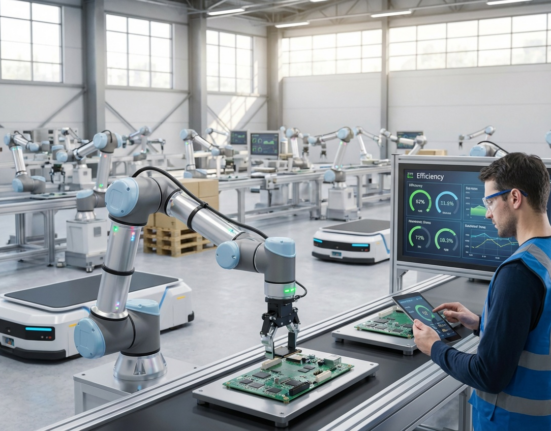Introduction: Why Upskilling Matters in Collaborative Robotics
Collaborative robots, or cobots, are reshaping industries by blending human creativity with robotic precision. But the true key to success isn’t just the machines — it’s the people managing them. Collaborative robotics upskilling ensures employees adapt, embrace new roles, and thrive in this evolving workplace.
What Are Collaborative Robots?
Cobots are designed to safely work alongside humans, unlike traditional industrial robots that operate in isolation. Their adaptability makes them ideal for manufacturing, healthcare, and logistics.
The Importance of Collaborative Robotics Upskilling
Boosting Productivity
Skilled workers manage cobots more effectively, improving efficiency across tasks.
Improving Safety
Training reduces risks and builds trust in human-robot interactions.
Enhancing Employee Confidence
Upskilling empowers staff to see cobots as partners, not threats.
Driving Innovation
Employees trained in cobot use unlock new problem-solving opportunities.
Challenges in Collaborative Robotics Upskilling
Resistance to Change
Employees may fear job loss instead of seeing new possibilities.
Skill Gaps
Many workers lack technical expertise for cobot programming or oversight.
Training Costs
Upskilling requires time, investment, and resources.
Balancing Workloads
Training must fit alongside daily responsibilities.
Strategies for Effective Collaborative Robotics Upskilling
1. Assess Current Capabilities
Identify gaps in technical knowledge and practical skills.
2. Offer Hands-On Training
Workshops with cobots build confidence and competence quickly.
3. Highlight Collaboration, Not Replacement
Communicate that cobots enhance, not replace, human work.
4. Partner with Experts
Leverage robotics firms and training institutions for advanced programs.
5. Commit to Continuous Learning
Ongoing training keeps workers updated on evolving technology.
Best Practices in Collaborative Robotics Upskilling
Start Small
Introduce cobots in pilot teams before scaling across departments.
Use Simulation Tools
Virtual learning lowers risks and speeds training.
Encourage Peer-to-Peer Learning
Knowledge sharing fosters collaboration and stronger teams.
Track Progress
Measure productivity, safety, and employee confidence after training.
Case Studies of Collaborative Robotics Upskilling
Manufacturing
Automakers train staff to oversee cobot assembly lines.
Healthcare
Hospitals upskill staff to use cobots for sterilization and patient handling.
Logistics
Warehouses train workers to coordinate cobots in sorting and packaging.
The Role of Leadership in Upskilling
Leaders must build trust by clearly explaining how cobots benefit both the company and employees.
Future Trends in Collaborative Robotics Upskilling
AI-Powered Training Tools
Adaptive learning platforms personalize training for individuals.
Blended Learning Approaches
Combining e-learning with hands-on practice ensures better retention.
Certification Programs
Industry-wide standards for cobot training will emerge.
Balancing Technology and People
The success of cobots depends on people’s ability to work with them. Upskilling bridges the gap, ensuring both thrive together.
Conclusion: Building the Future Workforce
Collaborative robotics upskilling is more than a training program — it’s a mindset shift. By investing in people, companies ensure cobots deliver maximum value while employees grow with the technology.
FAQ
1. What is collaborative robotics upskilling?
It’s training employees to work safely and effectively with collaborative robots.
2. Why is upskilling important for cobot adoption?
It boosts productivity, builds confidence, and improves safety.
3. What challenges do businesses face in upskilling?
Skill gaps, training costs, and resistance to change are common barriers.
4. How can companies start collaborative robotics upskilling?
Begin with pilot programs, partner with experts, and encourage peer learning.
5. Which industries benefit most from cobot upskilling?
Manufacturing, healthcare, and logistics are leading adopters.








